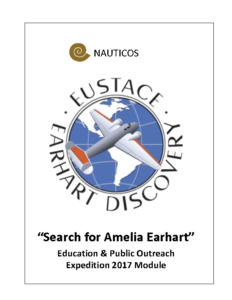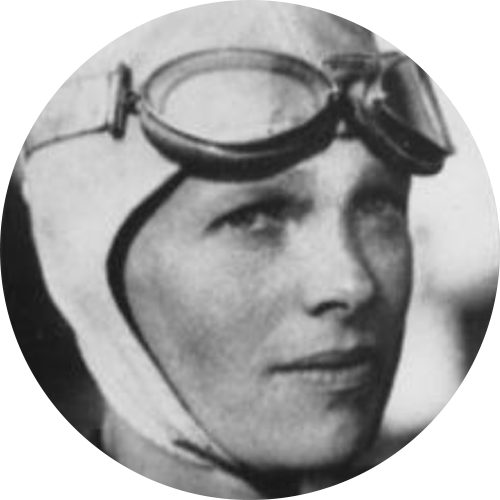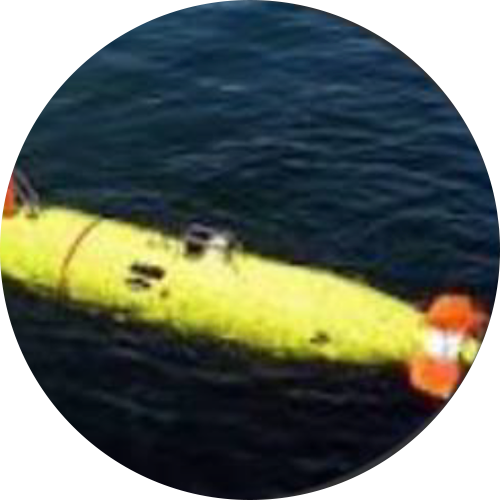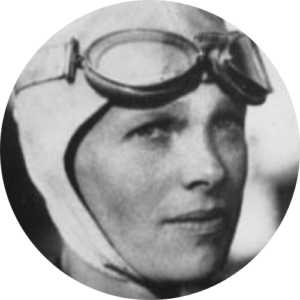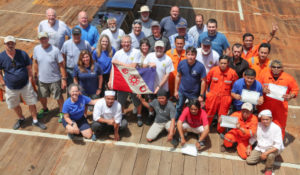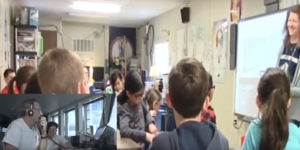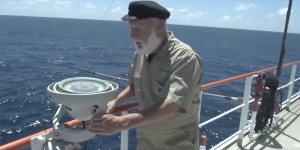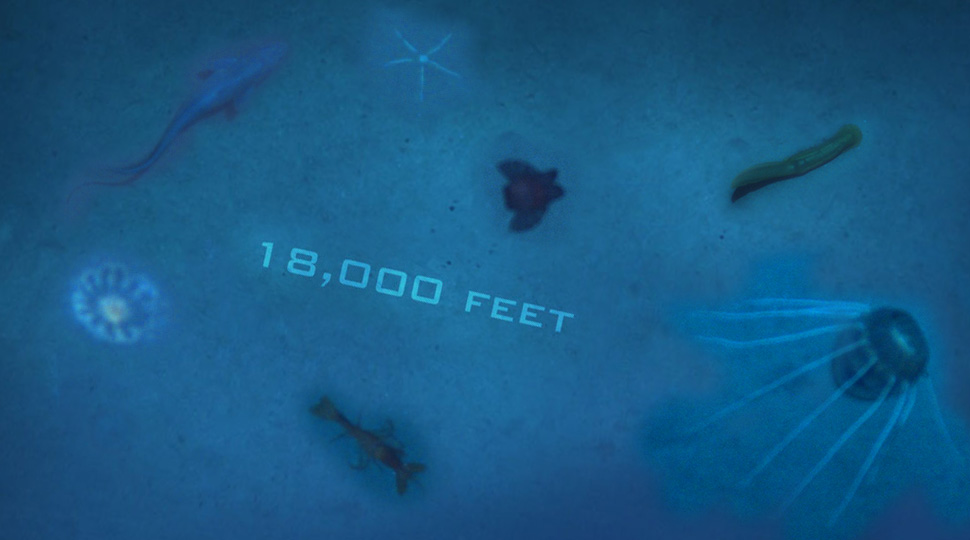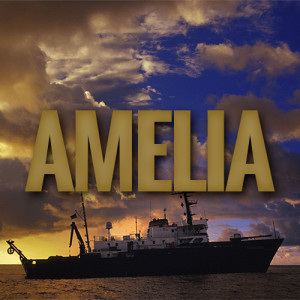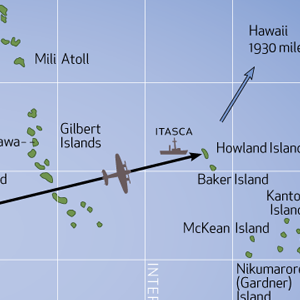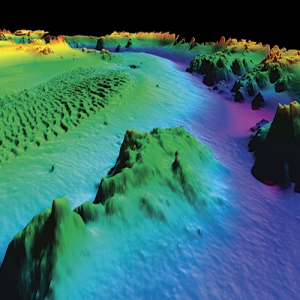Meridian Passages, Volume XIII, Number 27
Central Pacific Edition
The Team
Cast & Crew
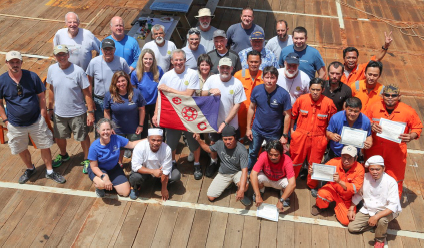
crew not pictured – someone had to steer the ship!
The Meridian Passages staff have fielded requests for a list of personnel aboard. Included here are the 36 folks sailing on Mermaid (counting Alan who was with us March 4-14) and the Nauticos team ashore providing regular & critical support. Of course, there are also folks at WHOI, MMA Offshore, U. of Hawaii, ship agents, crews of SauVage & Machias, CARC Cedar Rapids, NOAA, NASA, and helpers scattered around the hemisphere, not to mention our friends & families at home who are missing us and helping in many ways.
Roles listed here are primary duties, though everyone pitches in to get the job done.
Alan Eustace – Expedition Leader
Dave Jourdan – Coordinator & Publisher
Elgen Long – Advisor
Operations
Spence King – Operations Manager
Tom Dettweiler – Technical Manager
Greg Packard – AUV Team Leader
Jeff Morris – Chief Sonar Analyst
Joe Litchfield – Ship liaison & Seadog
Christopher Griner – AUV Operator
Neil McPhee – AUV Operator
Mark Dennett – AUV Operator
Radio Communications
Tom Vinson NYØV – Comms
Rod Blocksome KØDAS – Comms Media
Bill Mills – Director of Photography
Bryan McCoy KAØYSQ – MacGyver
Education & Outreach
Sallie Smith – Teacher
Marika Lorraine – Journalist
Sue Morris – Imagery & Ops Support
At-Sea Support
Jon Thompson – Exhibitionist
Pam Geddis – Doctor & Impersonator
Ashore Support
Charlotte Vick – Ashore Logistics & PR
Louise Mnich – Negotiator & Legal-beagle
David Kling – Master of Coin
Jenne James – Ashore Coordinator
Bethany Lacroix – Website & Comms
Mermaid Vigilance Crew
Noe Flores Armenta – Master
Lania Kurniauan – Chief Officer
Rifky Harimadya – 2nd Officer
Oleksandr Baybak – Chief Engineer
Andriyanto – 1st Engineer
Samsul Bachri Leorima – 2nd Eng.
Sergiy Stepanov – ETO
Iksan Natta – Bosun
Abdullah Mahmud – AB
Ahmad Derita – AB
Burhan Andi – AB
Kasmawir – Oiler
Kasman Sonne – Oiler
Jan Pieter – Chief Cook
Mardan Andi Kanna – 2nd Cook
Susanto Doni – Steward
Message from SauVage
[In reply to our farewell message sent yesterday…]
Thanks for those sweet words. We never thought that our old sheet padding fabric would be so much appreciated! Enjoy the wines. We wish you the best for the research and we feel honored to have been part of this exciting mission. We read the books! So interesting! And meeting Alan is great. We are sailing in optimal conditions, no swell, good beam winds, smooth glide. Still 480 NM to go.
Cheers, Sophie, Didier, Cloe, Nino, Alan
The Fate of the Itasca
We know that the US Coast Guard procured ten cutters of the Lake class commissioned starting in 1928. Each carried the name of a lake in the United States. My research shows the US Government transferred the cutters to Great Britain in 1941 under the lend-lease program. The British rechristened the ships with new names and refitted the ships for war.
The Pontchartrain (HMS Hartland) and Mendota (HMS Walney) were both sunk by gun fire on Nov. 8, 1942 off the coast of Oran, North Africa and the Sebago (HMS Culver) was torpedoed and sunk by the German sub U-105 on Jan 31, 1942. The remaining seven former Lake class cutters (Chelan, Tahoe, Champlain, Itasca, Saranac, Shoshone, and Cayuga) were returned to the United States after the war – probably nearly worn out. The trail of Itasca (HMS Gorleston) ends in 1950 with it being sold for scrap.
My family once owned a 1950 Ford sedan. Perhaps it contained some of the Itasca’s steel?
— Rod Blocksome
Meridian Passages, Volume XIII, Number 26
Central Pacific Edition
Farewell
Alan Begins Journey Back to Civilization
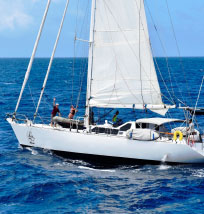 We were sorry to see Alan depart today on the sailing vessel SauVage, bound for Funafuti, then Fiji, then the Mainland and eventually to Lancaster, PA. It will take him about five sailing days to cover the over 600 nautical miles to the Funafuti atoll south of here, and considerably less time to make it the rest of the way to Pennsylvania.
We were sorry to see Alan depart today on the sailing vessel SauVage, bound for Funafuti, then Fiji, then the Mainland and eventually to Lancaster, PA. It will take him about five sailing days to cover the over 600 nautical miles to the Funafuti atoll south of here, and considerably less time to make it the rest of the way to Pennsylvania.
Unfortunately, owning to timing and short scheduling window of this expedition, Alan was unable to spend the entire search mission on board. However, the ten days he spent with us were a great experience for all. He was able to immerse himself in our operations, catch up with details of the analysis work that underpins our search having all the experts at hand, and dive into the technology of REMUS and our sonar analysis tools. In a few short days he became an integral part of the team and said he enjoyed the camaraderie. Before he left, he thanked the Captain and crew for their hospitality and left us with some words of support and encouragement.
 Spence reported feeling separation anxiety in response to losing a shipmate. Doc Pam examined him, expressed only mild concern, and prescribed a dose of Oreos. Pam herself was seen trying to climb over the rail as the sailboat departed, but was restrained by Bryan who slapped a running taut line hitch around her wrist.
Spence reported feeling separation anxiety in response to losing a shipmate. Doc Pam examined him, expressed only mild concern, and prescribed a dose of Oreos. Pam herself was seen trying to climb over the rail as the sailboat departed, but was restrained by Bryan who slapped a running taut line hitch around her wrist.
The crew of SauVage took on a load of fuel from us, and returned the favor with a swag bag of goodies. Included was a lube oil filter for the Engineer, a SauVage t-shirt, some fancy scarves, a postcard, and three bottles of spirits. Doc Pam immediately took custody of the alcohol, and said she would inventory it in her cabin. She expressed “concern” that it be administered properly. (Did we mention this is a “dry” ship?) After departure, we sent the following message to the Captain and crew of SauVage:
Thank you for your kind gift of nice wines, liqueur and colorful fabrics. These things thrilled our team. Our captain was most pleased at the sight of the fuel filters; our ladies were most excited for the chance to improve fashion around here; and we all are looking wistfully at the wines and liqueur. The vessel owners did not think to provide us any cork pullers. But we have engineers, so don’t worry about us.
We hope you get off to a good start and have a safe trip to Funafuti.
For Alan:
From all of us here we join together to say thank you for sharing time with us and showing your support in so many ways. We all share the passion for discovery, and we’ll pursue the truth wherever the facts lead us until the sea finally gives up her secret. We’re proud to sail for the Eustace Earhart Discovery Expedition. And yours was the most memorable arrival and departure we’ve seen yet.
The Eustace-Earhart Discovery Team
Meridian Passages, Volume XIII, Number 25
Central Pacific Edition
Mapping the Earth
One Swath at a Time
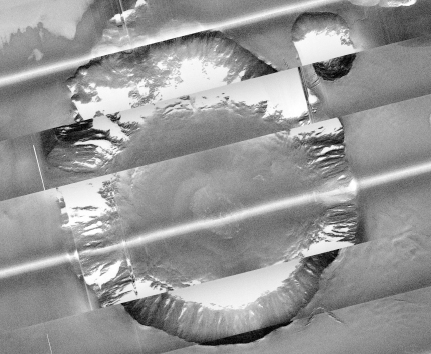 We have been scanning the seafloor for just over two weeks now and every day holds new discoveries. Though we like flat, boring terrain (all the better to see the Electra), we can’t help but be fascinated by the seep-sea world unfolding before us. With each recovery of REMUS, we eagerly scroll through the data to see what we have found.
We have been scanning the seafloor for just over two weeks now and every day holds new discoveries. Though we like flat, boring terrain (all the better to see the Electra), we can’t help but be fascinated by the seep-sea world unfolding before us. With each recovery of REMUS, we eagerly scroll through the data to see what we have found.
Over 90% of the seafloor around here is flat as Kansas, but it is dotted with volcanic ridges, landslides, calderas, and cinder cones that occasionally stick up hundreds of meters or more. There are even major seamounts just outside of our search area, the most dramatic rising over 3,000 meters (10,000 feet) from the sea floor (but the peak is still over 2,000 meters deep).
A particularly interesting feature was recently imaged, which we call Packard’s Cone in honor of our REMUS OPS team leader. The image mosaic here reveals a perfectly circular rise reminiscent of Meteor Crater in Arizona … but half again as big and certainly of volcanic (vice impact) origin. The profile is also quite different, as this feature is actually a cone rising from the bottom rather than a depression (see illustration on page 2).  The rim of the 1.8 km (1 nm) diameter feature rises 241 meters (almost 800 feet) from the seafloor, and its central cone is 389 meters (nearly 1,300 feet) high. As impressive as it is, we have imaged other much larger features this week including a seamount 16 km (8.5 nm) in diameter and 900 meters (3,000 feet) high.
The rim of the 1.8 km (1 nm) diameter feature rises 241 meters (almost 800 feet) from the seafloor, and its central cone is 389 meters (nearly 1,300 feet) high. As impressive as it is, we have imaged other much larger features this week including a seamount 16 km (8.5 nm) in diameter and 900 meters (3,000 feet) high.
None of the terrain we are mapping has been seen by humans before, so we give them our own names … Mt. Vinson, Dann’s Depression, etc. Technically, we can submit name suggestions to the cognizant government agency, which can choose to officially sanction them on future maps. However, they don’t like to name things after living people, so no one is volunteering to have an undersea mountain named after them any time soon.
Expedition Update
Amazingly, three vessels are on their way to our very remote location. S/V Sauvage will be rendezvousing with us around Wednesday to take Alan back to shore from where he can fly to to an engagement with fellow stratospheric explorer Joe Kittinger in Lancaster, PA. We’ll be saying farewell to a shipmate, but hope to bring him good news when we return. The next day we expect to see NOAA’s R/V Okeanos, out here exploring the Remote Pacific Islands Marine Sanctuaries. We may have an opportunity to visit them at sea. S/V Machias got underway from Honolulu yesterday bringing us a re-supply of transponder floats (and possibly some chocolate)! We’ll see her in about a week.
Nauticos News Night 09 — STEM Students and Radio Guys 1
It’s News Night on Mermaid Vigilance! A classroom of STEM students participate in a remote lesson via radio as Nauticos and the Eustace Earhart Discovery Expedition team search the Central Pacific for Amelia Earhart’s lost Lockheed Electra.
Meridian Passages, Volume XIII, Number 24
Central Pacific Edition
Milestone Merriment
Halfway Day a Hit
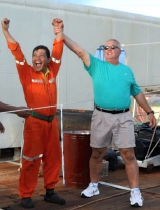 It is a sailing tradition to celebrate the halfway point of a cruise, even if you’re not sure exactly when that point will occur. The Nautical Rodeo idea was conceived by Spence and Sue when they realized that the halfway point was just one day away. The timing was perfect to incorporate the event into our regular Sunday bar-b-cue. Some games and prizes were cooked up in a hurry. Bryan was asked to host the event as MC. A sound system and music was added and a firepit was concocted using the barb- cue grill. The program included dancing under the full moon, and a nightcap of smores.
It is a sailing tradition to celebrate the halfway point of a cruise, even if you’re not sure exactly when that point will occur. The Nautical Rodeo idea was conceived by Spence and Sue when they realized that the halfway point was just one day away. The timing was perfect to incorporate the event into our regular Sunday bar-b-cue. Some games and prizes were cooked up in a hurry. Bryan was asked to host the event as MC. A sound system and music was added and a firepit was concocted using the barb- cue grill. The program included dancing under the full moon, and a nightcap of smores.
We started the festivities with dinner at 5PM (a practical move as the Equatorial sun is quite intense at noon). Folks broke out their party attire (except the REMUS OPS team who were facing an imminent AUV recovery – the survey never stops!) Dave (decked out i n Hawaiian shirt and dreads) followed with a few remarks about the tradition of Halfway Day, and recognized the excellent service from the galley team, Pieter, Mardan and Susanto.
MC Bryan took over the mike to explain what an American Rodeo is all about: “The American cowboy after a long week of wrangling cattle out on the trail would be anxious for a bit of recreation. So they got together with other cowboys and show off their wrangling skills by roping calves, riding bulls and their horsemanship. It started out as recreational activity for cowboys, and today it has become a spectator sport, in which the competition is fierce and huge prize money i s awarded. There are not too many cowboys in these parts, but we have plenty of mariners. This Nautical Rodeo is a mariner skills participation event. Everyone is welcome to try.”
 The first event was Competitive Knot Tying. Participants each had a piece of line in their hand, and upon the signal to start, judge Spence gave them a knot to tie. The quickest draw won.
The first event was Competitive Knot Tying. Participants each had a piece of line in their hand, and upon the signal to start, judge Spence gave them a knot to tie. The quickest draw won.
The second event was the Heaving Line Toss. Participants each had three tosses of the heaving line in an attempt to drop the monkey fist in the bull’s eye, a trash can. The last event was the Jellyfish Throw. Teams of two tossed a water filled latex glove to their partner on the signal from the referee. After successful throws, one team member took a step backward, and tossed the glove back to their partner.
Prizes were awarded at the end of competition: an autographed photo of Pamelia Earhart, who regretfully could not be here.
The Rodeo wrapped up to much laughter and many splattered “jellyfish.” Unfortunately, clouds interfered with views of the simultaneous sunset & moonrise, but we were confident the events occurred anyway. Next was the bonfire. Music and dancing ensued.
A brief squall sent the revelers running for cover, and serving of Indonesian Style S’mores was postponed because REMUS operations and data analysis was started. They were served in the mess for snacks. Traditional s’mores, that gooey chocolatey marshmallowy thing between graham crackers was not possible. Chef Pieter has never heard of marshmallow before. He googled it and found that he didn’t even have the ingredients to make them. So instead he improvised a chocolate and peanut butter concoction between two wafer things. It was really quite good. He dubbed it “Indonesian style.”
Meridian Passages, Volume XIII, Number 23
Central Pacific Edition
From Sea to Space
The Radio Guys Try to Contact the Mother Ship
 November Alpha One Sierra Sierra … this is November Yankee Zero Victor Maritime Mobile, Region 3 aboard the Research Vessel Mermaid Vigilance calling…”
November Alpha One Sierra Sierra … this is November Yankee Zero Victor Maritime Mobile, Region 3 aboard the Research Vessel Mermaid Vigilance calling…”
“Comm” Tom’s plaintive calls reached over the airwaves, trying desperately to make contact with the space ship whizzing overhead. It was our only chance … he just had to get a reply ….
“We must be on you, but can’t hear you … pretzels are running low …”
But it was useless. The orbiting space station dropped overr the horizon, leaving just a few meager “data packet bursts” t o tantalize us. Actually, this is not a science fiction story (though it may contain a few “alternative facts”). Inspired by our success during previous expeditions, the Radio Guys decided to see if they could get in touch with the Space Station. Turns out that two of the current residents, astronaut Commander Shane Kimbrough and Mission Specialist Thomas Pesquet are Hams, so they talk Rod, Tom, & Bryan’s language. They crafted a special hand-held antenna that could be pointed at the Station as it flew overhead (Don’t they have enough antennas already??), and with some help from Mermaid’s Electrical Engineer Sergiy, they got it working. They are also keen to speak with Peggy Whitson from Iowa, and we imagine our Russian-speaking friends on Vigilance may want to speak to the three cosmonauts on ISS.
A few emails to NASA (Kenneth Ransome at JSC Houston) got them the orbital transit times for our part of the world, and they were ready.
Marika and Sue held the antenna, Dave marked the transit times and azimuths (armed with Bryan’s green laser pointer), Tom manned the radio, and Rod-io supervised. Quite a crowd gathered for the 12:34 AM event, probably the largest congregation ever seen on the Mermaid’s bridge after midnight. Doc Pam was available (i.e., asleep in her cabin) in the event of injury. The Media Team was on hand to record the event, and a crowd of rubber-neckers hovered. It was probably just like waiting for Amelia on the Itasca!
As the transit began, Tom started his calls. “NA1SS” is the U.S. Amateur Radio Call Sign for the International Space Station. “NYØV” i s Tom’s call sign. “Maritime Mobile” identifies us as aboard a ship on the high seas. “Region 3” is the ITU (International Telecom Union) region of the world we are in, as agreed by international treaty.
Sadly, Tom’s calls were not answered, and we were all disappointed. Maybe the astronauts were asleep? Maybe they were afraid to be asked to teach a SEA School? Anyway, the Station will pass overhead regularly, and our Hams will try again.
Nauticos News Night 08 — Tour of MV 2 — Topsides
It’s News Night on Mermaid Vigilance! Tour the vessel with “Captain” Joe Litchfield as Nauticos and the Eustace Earhart Discovery Expedition team search the Central Pacific for Amelia Earhart’s lost Lockheed Electra.

